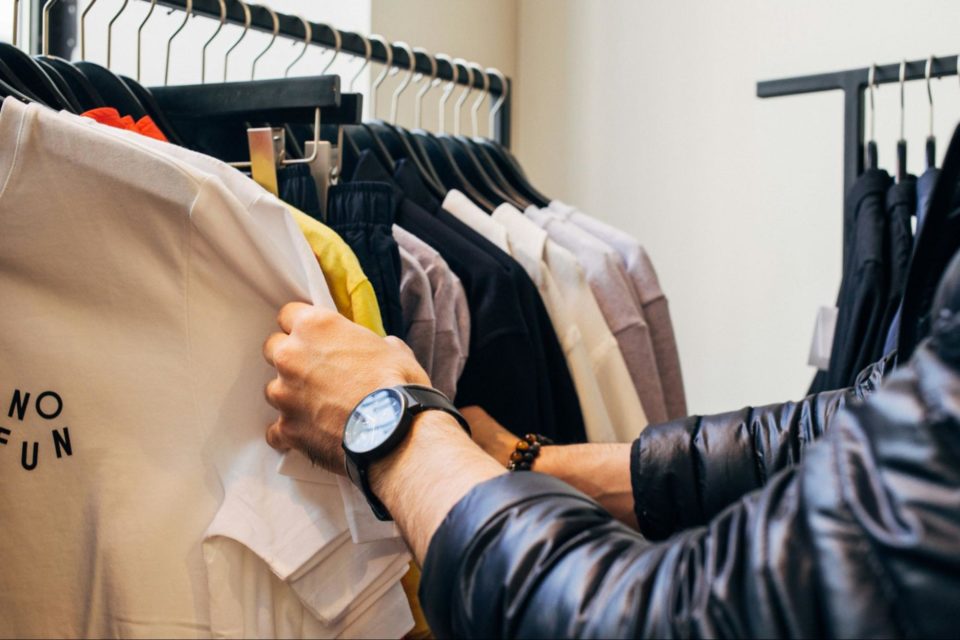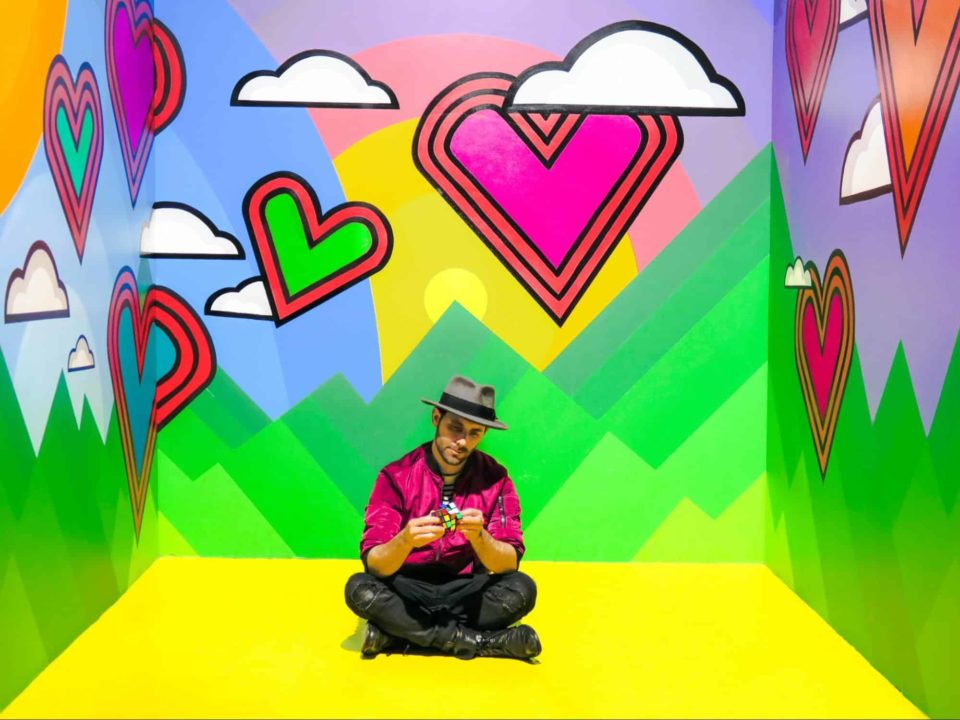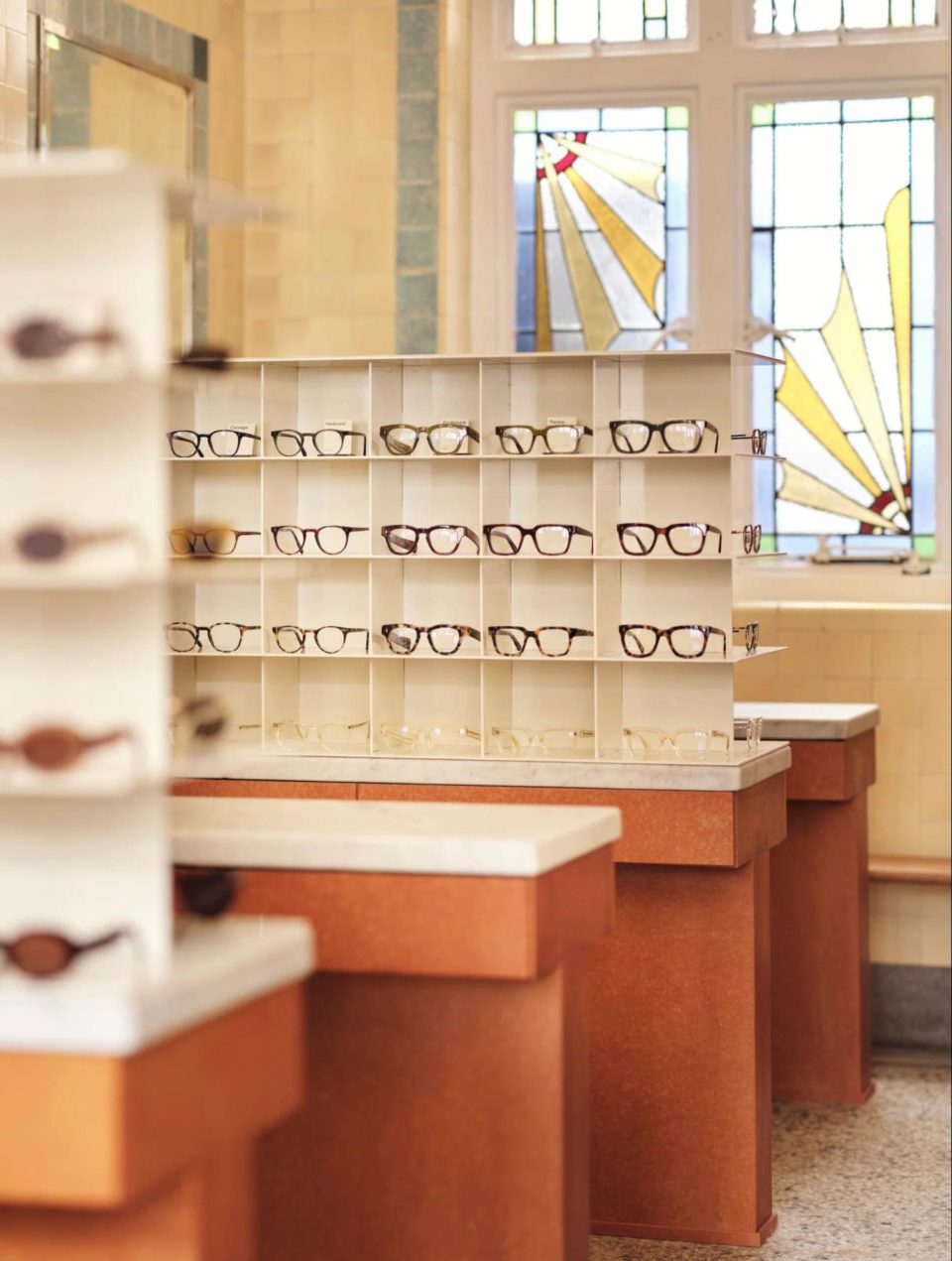The 50 Best Retail Ideas in 2023

Retail saw a change in 2023, with more investment and innovation in physical retail spaces, reflecting consumer desires following the pandemic.
Digital elements are still in play, enhancing online shopping and bricks and mortar stores, to provide convenience or unique personalisation to customers.
Community-focused retailing and sustainability were also two aspects that featured largely in retail last year.
We have put together 50 of the most exciting retail ideas we found in 2023 – read on for an idea of where the industry is heading in 2024.
Physical Retail
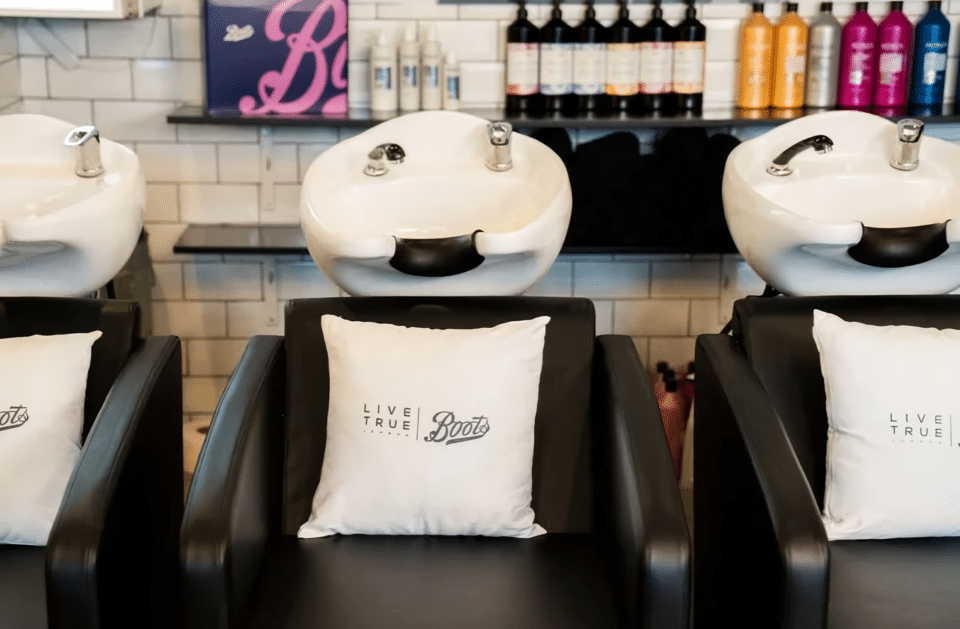
Image credit: Boots
1. Boots Beauty Store, London
Battersea Power Station is fast becoming one of the most popular locations for testing exciting new retail concepts.
Boots has recently opened a new concept store that aims to take skin care from the ordinary to the specialist and clinical, offering a range of treatments and masterclasses, but also helping customers with a number of common skin problems, such as acne and rosacea.
It is a great example of high street retail offering more high-end services, with dermatologists and scalp analysis, and skin rejuvenation treatments like Dermalux LED.
2. Peloton, London
A great way for retailers to refresh their brand is to expand existing stores to add further services and products to supplement the customer experience.
Peloton Studio in London opened a retail space next door to offer a range of further products and services to those taking classes, as well as potential new customers. These included Peloton merchandise, a juice bar to replenish after workouts, and a space for new events and activations, such as panels and pop-ups.
3. PrettyLittleThing, London
Influencers have become a significant part of retail, which is why we might see brands doing similarly to PrettyLittleThing and creating hubs aimed specifically at creators and celebrities.
As part of its new headquarters in London, the new showroom is not only visually appealing with its pink colouring, but has areas for press events, launches, and content creation. Products are made available for content, encouraging influencers to take photos and videos, and post about the brand online.
4. Taste56, NYC
Personalisation and bespoke services are rolling out across a range of retailers, including Taste56, which launched last year.
The store aims to make wine more accessible for customers, with a number of innovations to make wine selection easier. Firstly, customers can send in information about the wines they like before visiting the store, with staff choosing wines for them. Secondly, they can visit the store in-person for tasting, rating their choices online. This will provide them with a personalised list of wines.
Other touches around the store include descriptions alongside each wine, so customers can understand more about the wine and the terminology used.
5. H&M Keep The Presence concept, Manchester
An interesting retail approach we saw from H&M last year is Keep The Presence, a concept designed to keep parts of a physical store open while it is undergoing refurbishment.
Starting in Manchester, the store operated almost like a pop-up, with a curation of clothing for customers to purchase and click and collect options for those buying online.
It was coupled with digital activation, including special offers online at H&M Hub and AR rooms to explore upcoming homeware ranges.
It’s a great example of how brands can remain connected to customers even when the store is not fully operational.
6. Halo Paris, Paris
This year has seen a number of fashion labels and retailers open cafes and restaurants in-store as a way to expand their offering and encourage footfall, but Halo Paris has an interesting twist, with a hidden restaurant.
Visitors to the space will see a boutique with fashion from a range of young creatives, yet if they enter one of the fitting rooms they will find themselves inside a restaurant.
It is reminiscent of a speakeasy and gives a sense of exclusivity and being in the know, both for up-and-coming fashion and new buzzy eateries.
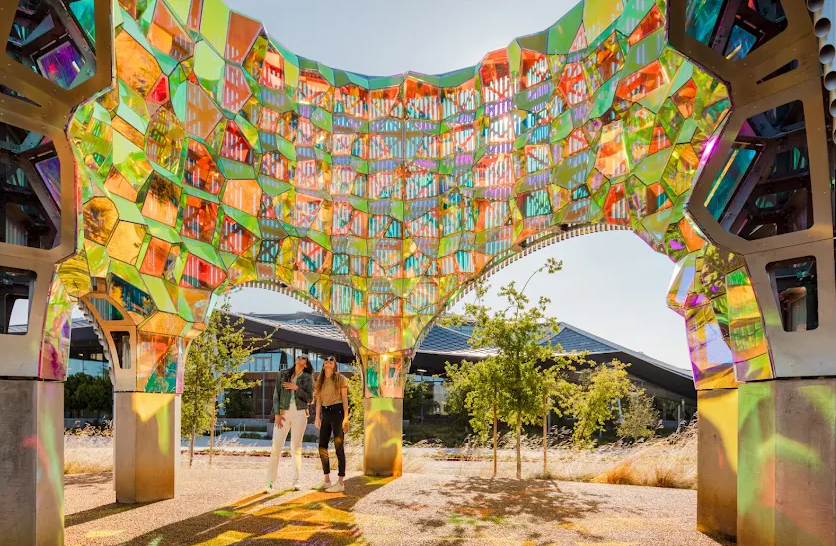
Image credit: Google
7. Google Visitor Experience, California
Tech giant Google has expanded its retail offering as part of a Visitor Experience Center at its Mountain View campus.
The tech company suggests that advances in the likes of AI makes physical spaces much more important, and that it also wants the opportunity to learn from, and involve, the community.
Leaning into the localisation buzz that we’ve seen this year, it reflects the desire of brands to connect with their communities and become a hub for events. The Google space includes a plaza for events, a café, an art gallery and a shop that includes local makers. This too reflects another retail trend for this year: collaboration with other brands and creatives.
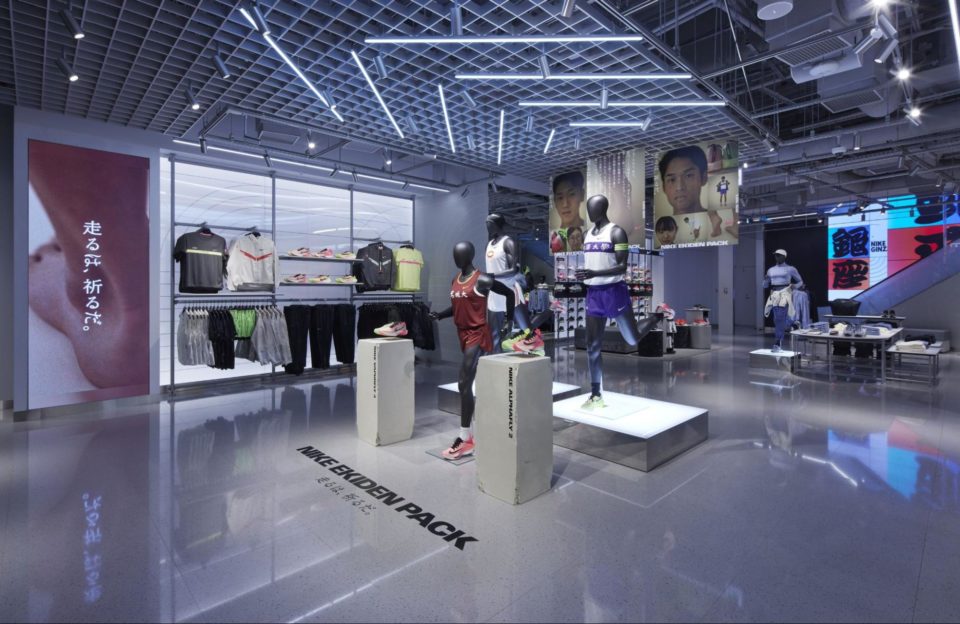
Image credit: Nike
8. Nike Running, Tokyo
One trend emerging from many athletic companies is tailoring stores to the local sport communities. Nike in Tokyo is no exception with the Nike Running store targeted at local runners.
The store is part of the Nike Rise strategy, which is geared towards athletic and sports enthusiasts. Nike releases footwear related to particular running events, and hosts training sessions and running events through the Nike Run Club. There is also a Running Hub for advice, services and meeting other runners.
9. Hypebeast, NYC
Hypebeast continues the evolution of making flagships and stores a hub for all of a brand’s products and services.
The new Hypebeast flagship contains 7 floors, some of which are the headquarters for North America. However, the space also hosts HBX, Hypebeast’s fashion platform featuring products across menswear and womenswear from 40 curated brands. There is a space for exhibitions and pop-ups, either for brands or for artists, as a place to build community. Hypebeans, the brand’s café, also has a location there.
It’s a great example of how editorial brands are taking their expertise and ability to create culture into physical spaces that speak to their target audience.
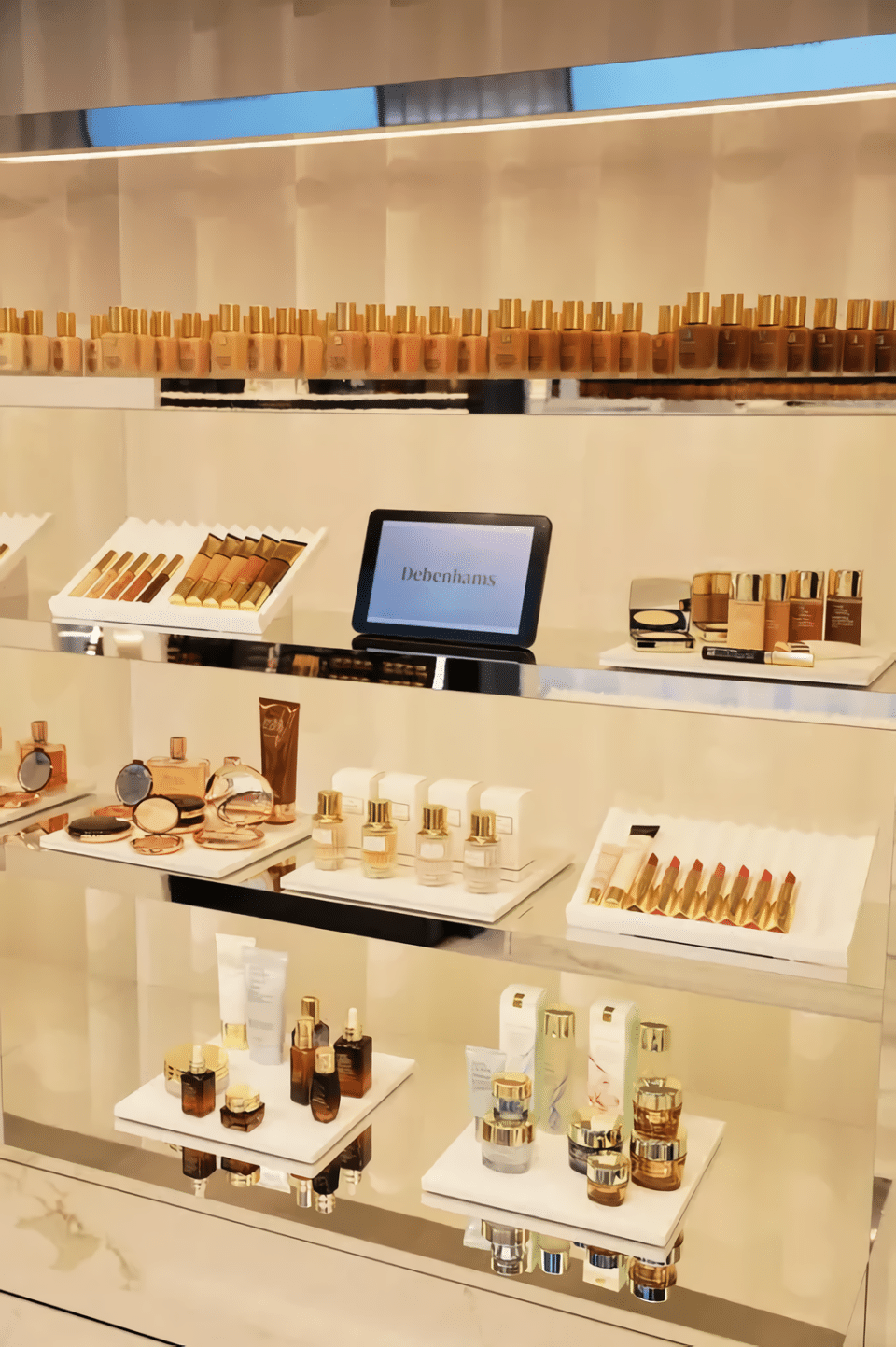
Image credit: Debenhams
10. Debenhams Beauty Showroom, London
Debenhams has opened a Beauty Showroom aimed at beauty enthusiasts as part of its phygital retail expansion.
The one-time department store brand is now digital-only but – like many retailers – recognises that customers still prefer to buy certain products, such as beauty, in-person.
The store offers a range of treatments, including consultations with its Beauty Experts and makeovers. Digital elements include tools for diagnosing skincare issues and trying on beauty products virtually, and tablets for finding products like fragrances and foundation.
Getting customers through the door also helps staff to build a closer relationship with them, echoing the experience of visiting a hair salon or beauty parlour.
11. Samsung Opera House, India
Building huge expansive flagships is a way for retailers to make their mark in a city, as well as attract the attention of customers and passing shoppers.
Including experience zones is also fast becoming the standard amongst technology and entertainment brands, allowing customers to try out electronic products before they purchase them.
The impressive Samsung Opera House has a zone for phones, gaming and smart homes, so that customers can get hands-on experience with Samsung products. It has also incorporated augmented reality for customers to see how an item will look in their home.
12. Moraeru Jihanki Vending Machine, Tokyo
We all know that a free gift can be a useful tool for encouraging people to complete a survey and it is fascinating to see such an innovative use of that idea.
The Moraeru Jihanki is a vending machine with a difference. Although it has a selection of products inside, they are not visible to the shopper. Instead the machine has a series of images instructing them to use their smartphone.
The customer finds the company’s Line account, chooses an item, completes the survey and then presents a QR code to the vending machine to get their chosen product. Items on offer included beauty samples, such as Hello Kitty face masks.
It’s a great example of how brands can gather customer data in new ways.
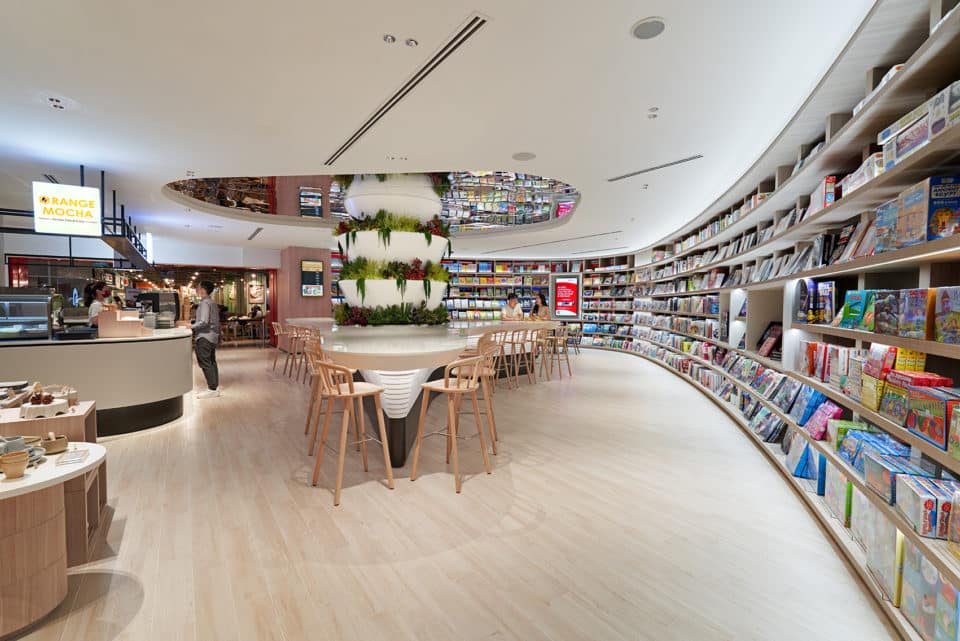
Image credit: OCBC
13. OCBC, Singapore
While much of banking is moving towards digital services and closing physical branches, OCBC is going in a different direction.
The bank suggests that physical spaces are helpful for retail customers needing assistance with mortgages and other loans, and also for wealth management for high net worth customers.
It has built a branch that also functions as a lifestyle experience to help OCBC to connect with its customers. Visitors can access a range of stores, offering products from books to homeware, visit an exhibition at the art gallery, eat at the café or omakase restaurant, or attend an event. OCBC will be hosting events that cover financial wellness and other workshops.
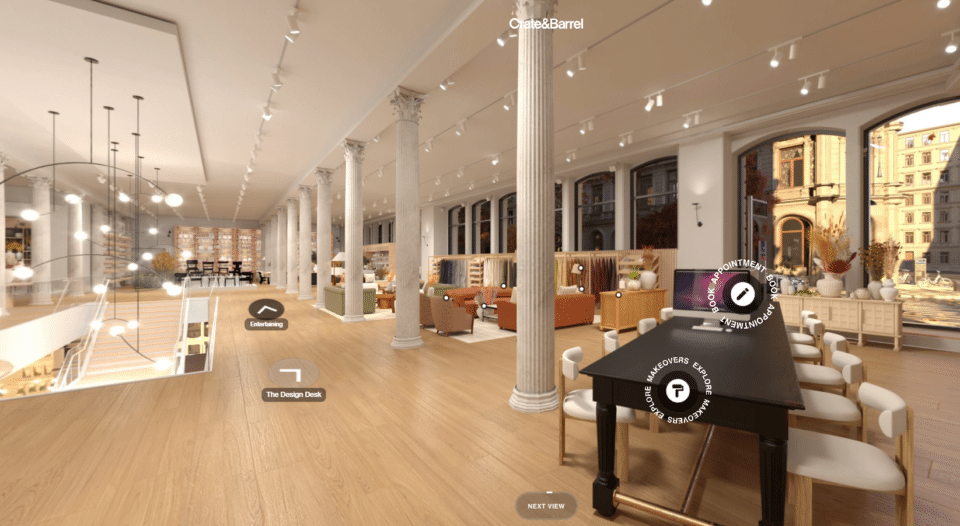
Image credit: Crate & Barrel
14. Crate & Barrel, NYC
Crate & Barrel are taking a different approach to homeware, while hitting on some of the trends that we have seen over the last year.
The store has taken a pared back approach to stock, ensuring that displays are minimalist and each item can be seen, which feels more purposeful, and akin to the museum trend that has been developing in retail.
The brand is also leaning into personalisation, from a monogramming service available for all textile products, to an interior design service to help customers plan out their rooms. There is also a virtual version of the store for customers to visit online, with shoppable items available throughout.
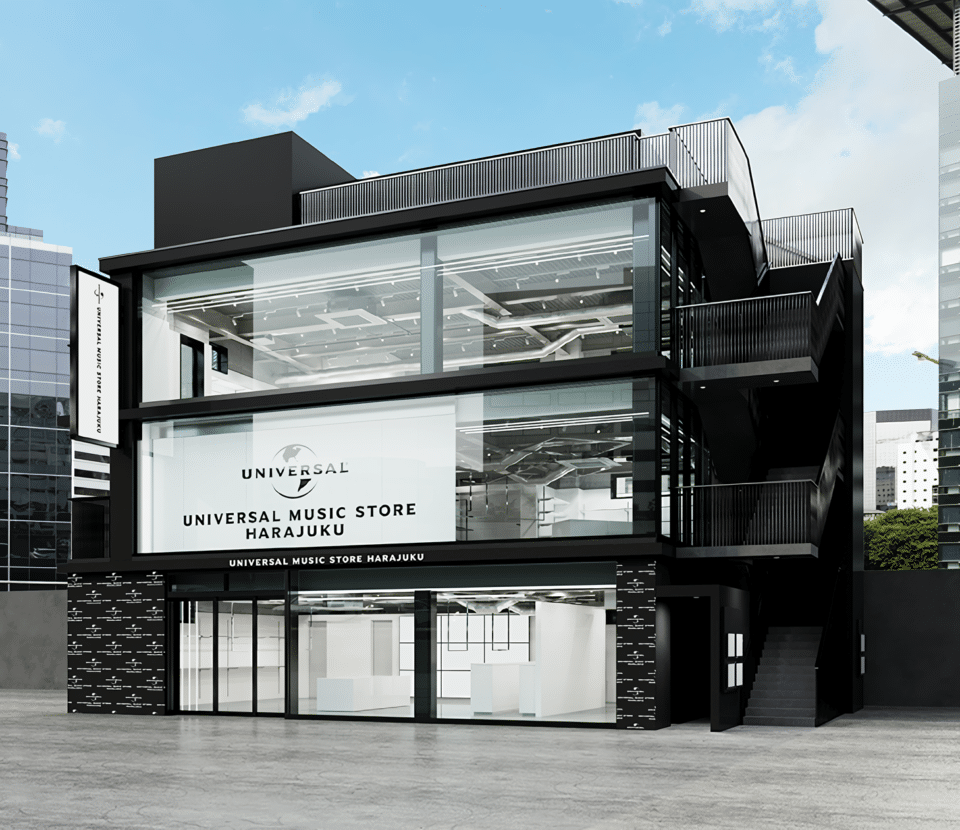
Image credit: Universal Music
15. Universal Music, Tokyo
With the rise of social media, music fans have become bigger and more dedicated than ever, and music retail has adjusted to meet the needs of these groups.
We are now seeing musicians move more into branding and merchandise, and taking part in collaborations, such as the Universal Music store in Japan, which partnered with The Rolling Stones.
These spaces not only offer merchandise and potential for live events and activations, but also wider entertainment experiences and pop-ups, to ensure that a fan can immerse themselves in the worlds of their favourite bands and artists. For fans of The Rolling Stones, this included London-themed elements, a new album, branded decorations and merchandise, all under the name RS No.9 Harajuku.
16. Uniqlo Opera, Paris
Making a retail space beautiful is not just limited to high-end luxury stores, as Uniqlo have proved with their recent strategy.
The brand has been choosing historical buildings for the location of its new stores, and then working with the history of the space. This not only allows the public to enjoy the building, but also elevates Uniqlo’s products, by displaying them in a picturesque setting.
The building’s location next to the building of the Paris Opera also allowed the opportunity for a unique collaboration between the two, with members of the Paris Opera appearing in promotional photography, and Uniqlo offering discounted Opera tickets. This, again, elevated Uniqlo’s products by associating them with a high culture activity.
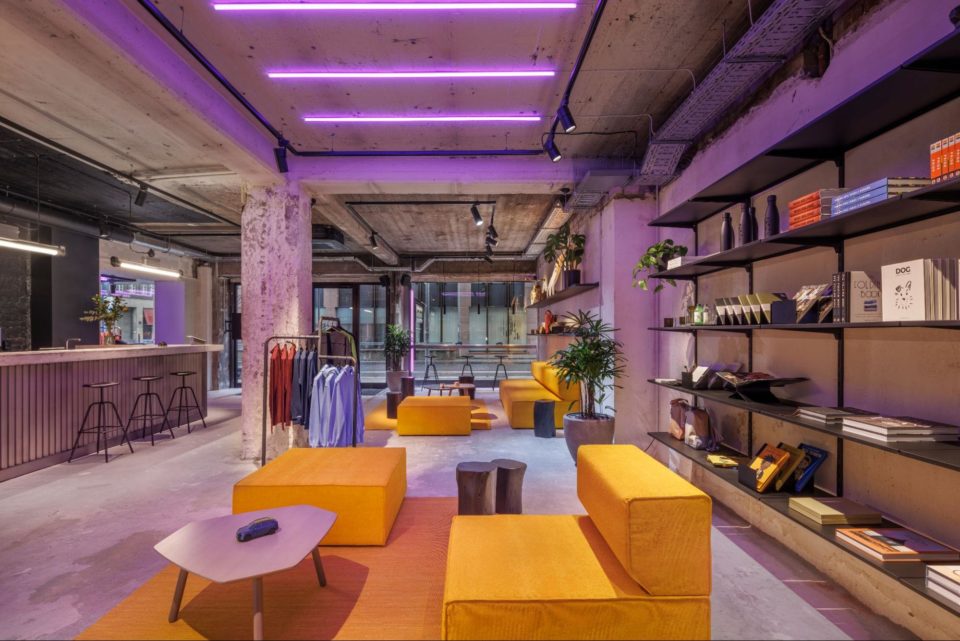
Image credit: Lynk & Co
17. Lynk & Co, Dusseldorf
Automotive brands are firmly established in the lifestyle space retail trend, moving away from showrooms filled with cars, to relaxing hubs and membership services.
Lynk & Co offers a car club membership for renting vehicles, with events and offers, and access to co-working and meeting areas, plus a lounge and café. The space also includes the Gear Collection store, which stocks a range of brands that Lynk & Co have partnerships with.
The space works because the car is almost an afterthought. It’s right at the back of the space with the focus on creating an inviting interior that consumers want to spend time in.
18. Tracksmith, London/NYC
Continuing the community-focused sports trend, Tracksmith ensures its stores serve the needs of local runners.
The brand conducts a range of research to find out about the running community in an area. It considers the proximity of well-known running areas (green spaces in London for the London store) and also large famous events (the New York marathon, for the New York store).
The stores also host a number of services, events and activities for runners, such as weekly running clubs, training sessions and locker storage.
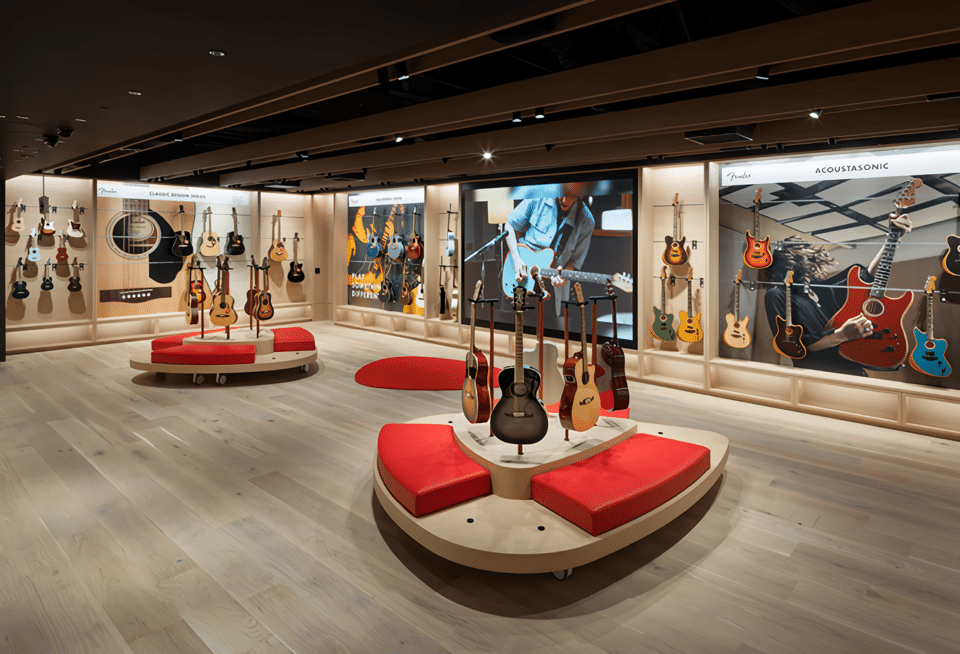
Image credit: Fender
19. Fender, Tokyo
Music shops have traditionally functioned as a space for meeting other musicians and finding out about lessons, and larger brands like Fender are tapping into this community spirit.
The retailer’s Tokyo flagship supports everyone interested in music, from beginners to professionals. The basement contains a space for community events, such as lessons and live shows, as well as the Fender Café.
The first floor is for instruments and merchandise, including Fender’s own clothing line, F is for Fender, while the second floor has a soundproof room for customers to test out instruments without an audience. The third floor taps into the personalisation trend, with the Fender Custom Shop, for bespoke guitars from expert builders.
20. Petco, NYC
The retail hub continues to be a popular strategy for brands, where a space is opened that reflects a collection of services offered, as opposed to a retailer simply selling products.
This is evident in the store Petco opened in Union Square, which it described as a Pet Care Center.
As well as its own branded products, it also offers a range of luxury branded items across clothing and portrait ranges. But it is the services Petco is offering which are of most interest as a retail idea. The brand has a pet kitchen on-site, in collaboration with JustFoodForDogs, as well as a veterinarian and animal hospital. Pet owners also have access to a self-service area to groom their pets.
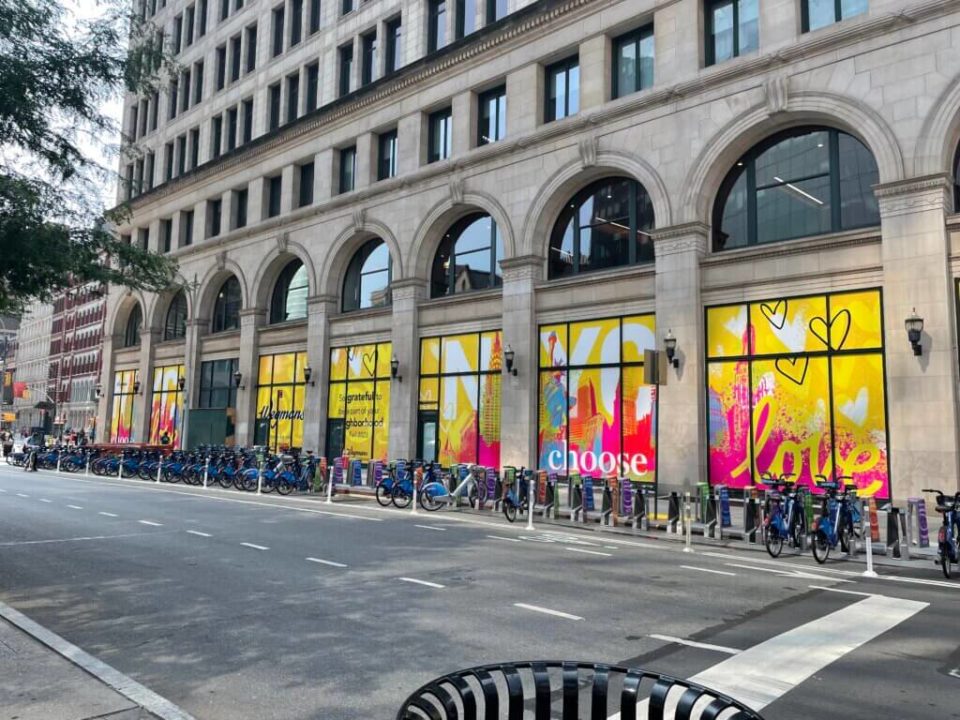
Image credit: Wegmans
21. Wegmans, NYC
Supermarkets are also trying to find new ways to attract customers by offering specialist services and connecting with local businesses.
Wegmans decided to focus on Japanese seafood for its new New York store, developing a new sourcing and training strategy to suit. This included adding trained Japanese fishmongers to its staff, to both manage the new department and who could in turn train existing staff on new cutting techniques. Customers are provided with specialist knowledge on how to prepare and cook their fish.
The brand also collaborated with a New York brewery for a local IPA, named after the store’s location.
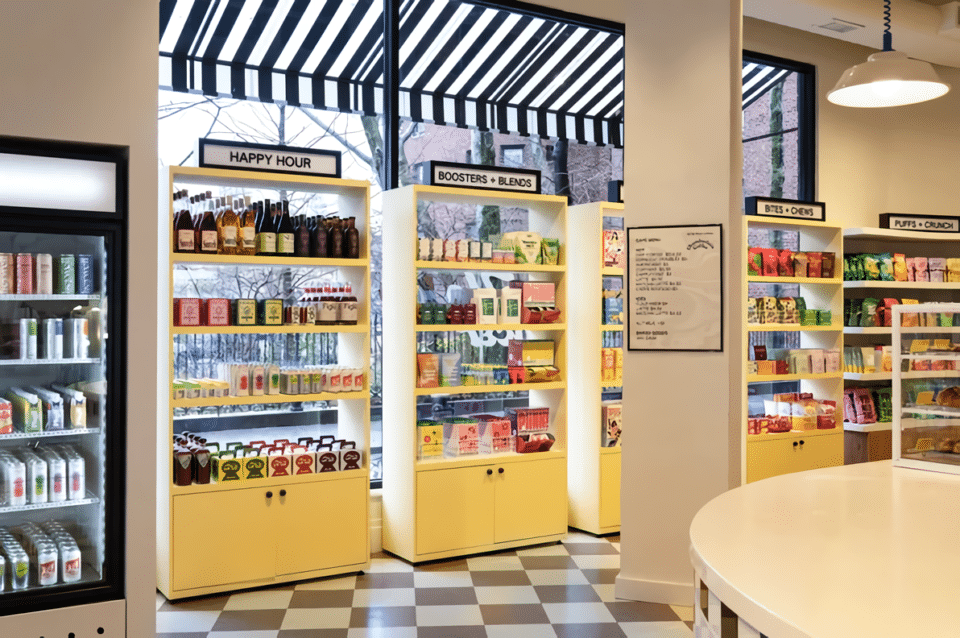
Image credit: Pop-Up Grocer
22. Pop-Up Grocer, NYC
Pop-ups are a great way to test the market and find out if a permanent physical site is suited to the brand. Pop-Up Grocer has done just this, having hosted a range of successful pop-ups, before launching a permanent site.
The store is influenced by museums and scouring to find unique items to display, but applied to food. Accordingly, the store finds a broad range of interesting and fun food items from new brands such as Fishwife and Tazzy Candy. The store has partnered with other brands to host its bakery and is holding events designed to connect with local foodies.
Digital Retail
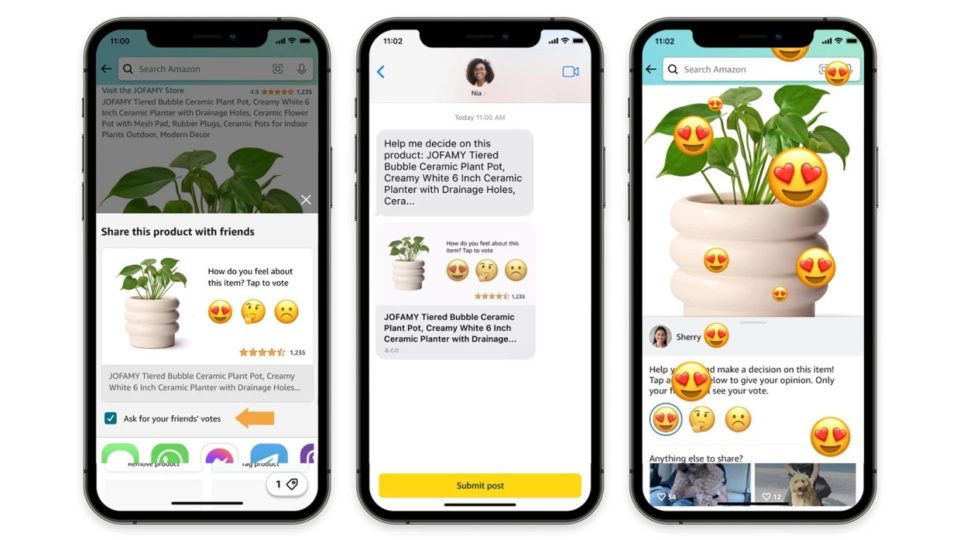
Image credit: Amazon
23. Amazon Social Shopping
Amazon is including social media style features to encourage customer interaction within its digital retail app.
Harnessing the power of recommendations, the addition of its latest experiential feature is designed to evoke the physical retail experience, of getting opinions and recommendations while shopping with friends and family.
Using its vast bank of data on how customers interact with the Amazon Shopping app, the company has found that the share option is regularly used to send items to friends and family via other social platforms. Consult-a-Friend can help shoppers get feedback on products within the Amazon app, where friends can use emojis to “vote” on items, and also reply with comments.
24. Coach AR, NYC
Augmented Reality (AR) has been an exciting innovation in the retail space, allowing customers the opportunity to test out products in new ways.
Coach implemented AR for people to use as they pass, before they have even set foot in the store. It placed an AR mirror within an exterior window, to allow customers to try on the Tabby bag as well as fun animations.
This provided customers with a teaser about the product, as well as how it looks, to encourage them to make a visit in-store.
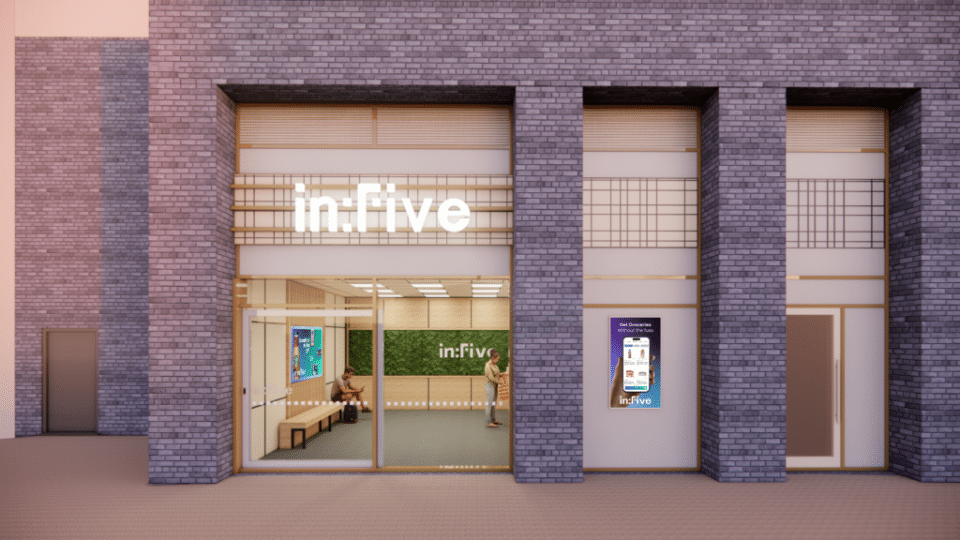
Image credit: In:Five
25. in:Five, Manchester
The UK saw the launch of an automated grocery shop in Manchester, blending digital and physical retail.
Customers order from the in:Five app and then go to the physical store to collect their items from a locker. The store is staffed entirely by robots and offers a wide range of goods, from well-known food brands, to exciting new drink brands and gadgets.
In order to purchase items with an age restriction, customers will need to use facial recognition software, which may be unappealing to those with privacy concerns. Brands in this space need to consider what data they are collecting from customers and balance that against the convenience of their offering.
26. Walmart Text to Shop, USA
Keep an eye on the rise of conversational commerce.
Walmart launched Text to Shop as a way to allow busy customers, such as parents, to simply send a text message for items they want to order. The service is linked to the customer’s account at Walmart, so that they are able to order a few items, or add products to an existing order.
This type of service offers convenience, as it allows customers out and about to order products as and when they remember, without having to log into their shopping cart.
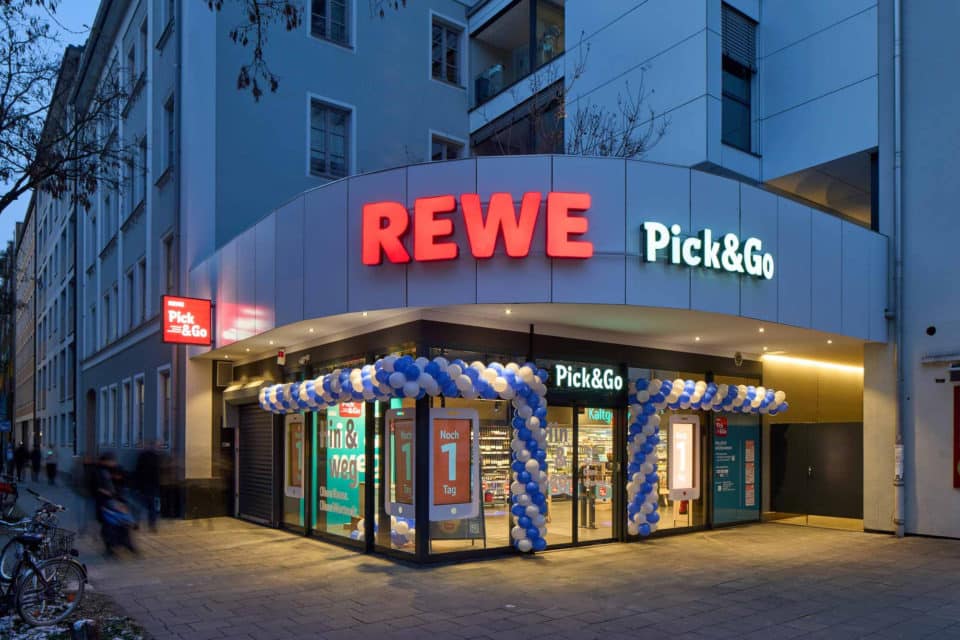
Image credit: BusinessWire
27. REWE Pick & Go, Munich
The interest in automated retail is picking up speed, with a number of stores popping up around the world.
REWE Pick & Go launched an automated supermarket in Germany, with a creative solution to avoid the use of facial recognition. Instead, the store uses a series of sensors and cameras to log data on products and people moving about the store, which is twinned with a digital version of the store.
Developments in this technology may pave the way for other retailers in Europe, due to stricter data protection laws in this area and growing consumer concerns about privacy.
28. Walmart Shoppable RomCommerce
At Christmas, Walmart launched an intriguing innovation – a Christmas series where viewers could purchase items shown – dubbed RomCommerce.
Taking advantage of the increasing popularity of social commerce, and features within TikTok such as Video Shopping Ads, the retailer offered 330 products from fashion to homeware. Even the name of the show Add to Heart sounds like add to cart, making audiences aware that they can buy the products they see.
Walmart points to research suggesting that increasing numbers of consumers want to buy items on social media, and it will be interesting to see if the idea of an original series with product placement will be more popular than regular ad content.
29. The Fragrance Shop, London
Personalisation has been an increasing presence across retail, with customised clothing and prints.
The Fragrance Shop has gone one step beyond, with a special AI perfume station, created in partnership with EveryHuman.
Customers answer some questions about themselves and the machine, Algorithmic Perfumery, creates three perfumes, with the option to order a bottle of any of the three scents if the customer likes them.
AI is increasingly being used to create unique products and ideas and implementing it within perfume is an innovative concept, allowing customers to benefit from a bespoke fragrance tailored to them.
30. Mastercard Shopping Muse
This past year has seen a number of new tools released that make use of the generative AI revolution.
Mastercard has used Dynamic Yield, which it bought last year, to create a new tool to help customers search for products.
It takes browsing history and the language used by shoppers, including colloquialisms and fashion trends like “cottagecore”, and creates tailored recommendations for customers, like a personal shopping assistant.
The quality of the recommendations should also increase the more the customer uses the tool, as it will learn what products they like. It can also help when the shopper is unsure of what they are looking for and has image recognition tools.
The company believes that AI is the solution for meeting customer’s personalisation needs and that increasing numbers of retailers are using or planning to use AI.
31. Google AI try-on
A very pivotal development is the expansion of virtual try-on for people shopping online.
Many online shoppers feel less confident buying fashion because the models do not look like them and it is difficult to tell how an item will look, leading to returns.
Google has built a generative AI model that understands fabrics and fashion construction, and can therefore manipulate an item of clothing from one static image to fit a variety of models. The models are 80 real individuals with different body sizes, skin tone and hair. Consumers can therefore pick the model closest to them to view a particular item.
A range of brands have already embraced the virtual try-on tech, such as H&M and Anthropologie, with more expected to be added in future.
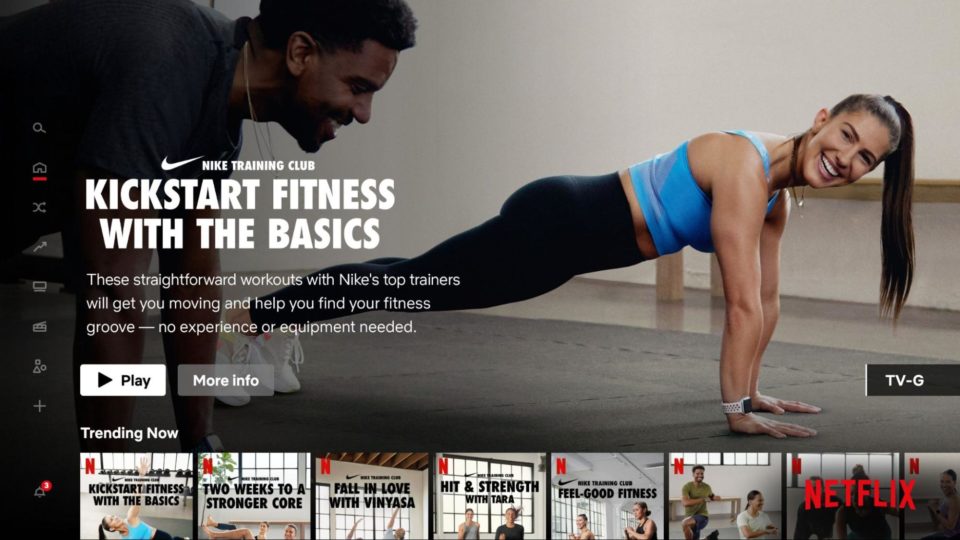
Image credit: Nike
32. Netflix/Nike Training Club
We are seeing an increasing number of brands take part in collaborations and partnerships this year, reflecting the changing nature of retail and the move towards offering services in addition to products.
This year saw a successful collaboration between Netflix and Nike, with Nike providing over 90 workouts across yoga, strength training and HIIT workouts from its Nike Training Club to Netflix. It is a clever idea, recognising that watching content has a tendency to be a sedentary activity, but people might be more inclined to take part in a quick 10 minute workout between shows.
For Nike, it is a great advert for its Nike Training Club, which is promoted as fitness for everyone, and what better way to do this than via one of the world’s largest streaming providers.
Luxury Retail
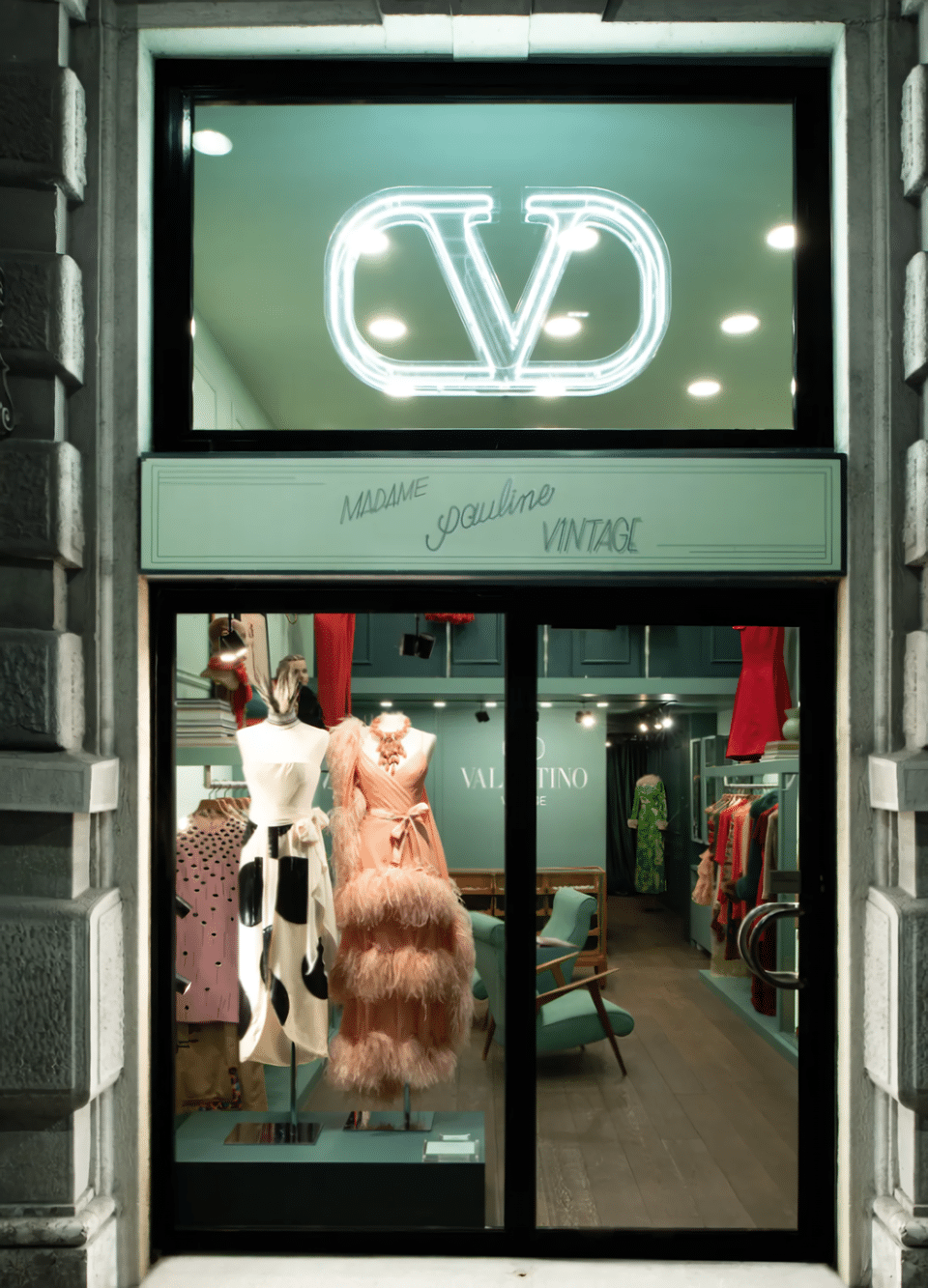
Image credit: Valentino
33. Valentino Vintage, Global
Sustainability has been a huge retail trend, reflecting the younger generation’s concerns about climate change.
Valentino Vintage aims to include luxury fashion within the circular economy, picking stores from seven fashion capitals around the world where customers can get their Valentino products assessed and receive a voucher to spend in Valentino stores.
The luxury house is also tapping into another trend of 2023: brand history. Vintage Valentino clothing will be on display across all seven stores participating in the initiative, and made accessible to fashion students at 1 Granary.
34. Gucci Salon, LA
Retro and vintage have become a considerable part of several luxury retailers’ branding and approach over the last year.
Gucci launched a new Salon harking back to its early days in Hollywood during the 1960s, with vintage furniture and glamorous chandeliers. The space is designed to be discreet and exclusive, aimed at Gucci’s most valuable clients, and is by invitation only.
The Salon will also adapt the space for each client, to ensure that not only are their needs met, but the items offered and the entire experience itself is one-of-a-kind. It’s an example of how luxury is doubling down on customer experience for its biggest spenders, as other aspects of luxury become more democratised.
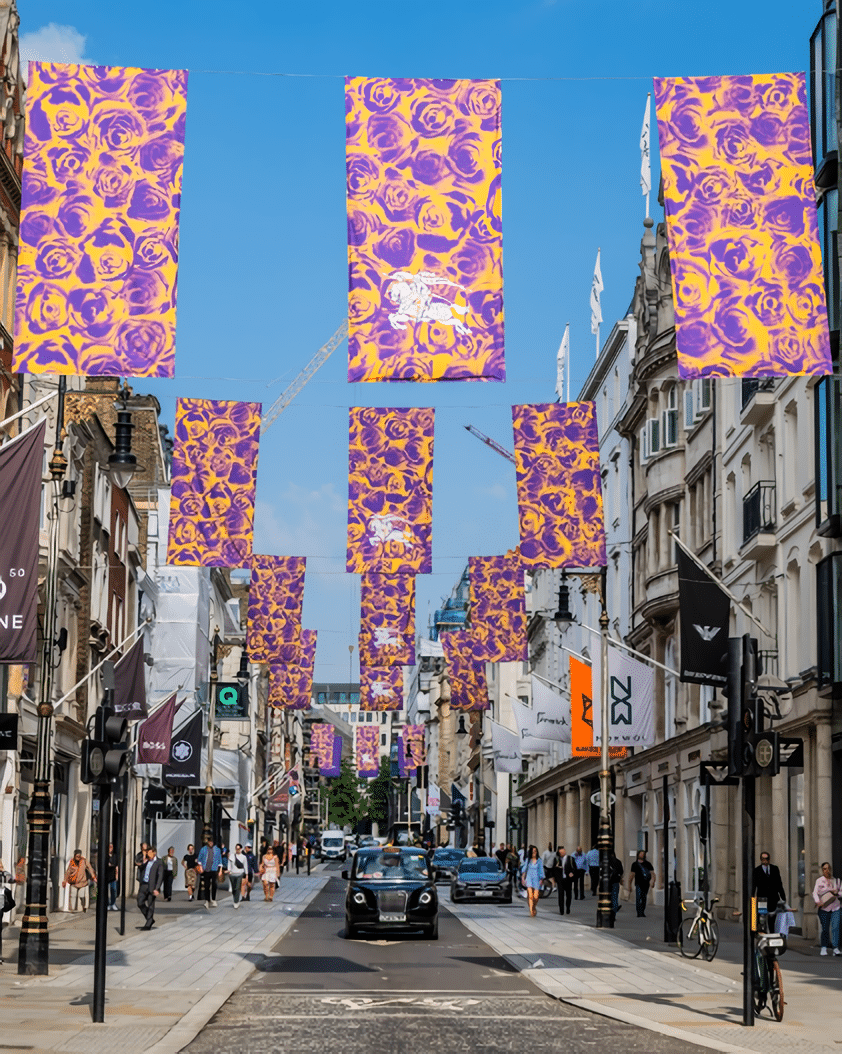
Image credit: Burberry
35. Burberry Streets, London/Global
Burberry Streets was an ambitious activation by the fashion house which saw it take over different cities, including London during Fashion Week.
The activation included a collaboration with café Norman’s, where it developed a special menu and rebranded the look and feel of the space, as well as a display of iconic Burberry prints and colours around London, including taxis and flags in Bond Street.
The most debated part of the activation was temporarily renaming Bond Street tube station “Burberry Street”. It is worth considering how best to make large scale activations work both for the brand and local community.
36. John Lobb, NYC
Slow and bespoke fashion is another interesting retail trend for some luxury brands.
Instead of attempting to compete with the flurry of fast fashion on apps and social media, the new John Lobb store has a bootmaker on-site who meets with customers to help create their shoes. The process takes months, with the measurements being sent off to Paris, and bespoke items being created.
The store does hold some ready-to-wear items, some of which are exclusive to the New York location.
37. Perfumer H, London
Many customers are beginning to understand that bespoke items take time to craft, and want to see or understand the process and story behind their purchase.
Fragrance brand Perfume H, with its store aesthetic of vintage and modern pieces, is creating that atmosphere for its customers. The store has a special testing system so that customers can find out what elements make up the scent of the perfume. This system is made up of test tubes and droppers, with an apothecary feel, giving the customer an idea of the craft that goes into making each perfume.
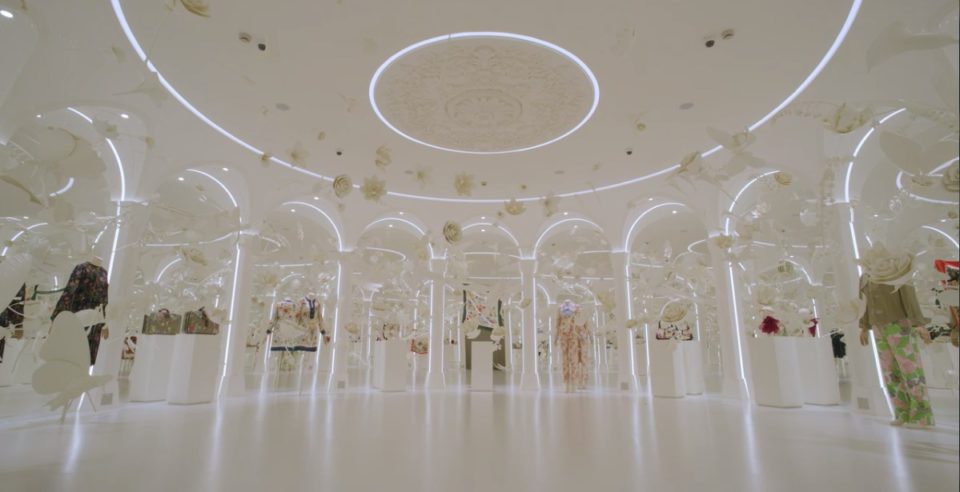
Image credit: Gucci
38. Gucci Cosmos, Shanghai/London
Exhibitions and archival displays have become a very popular brand activity for long-running luxury fashion houses to demonstrate their heritage and longevity.
Gucci launched Cosmos to showcase its 102 years as a luxury house. The exhibition was zoned into different areas, with titles like Eden and Archivo, designed to bring out a particular Gucci theme.
The display contains famous items from its archives and how Gucci has defined fashion across the last 100 years. Conceived by Es Devlin, an artist, the exhibition was curated by Maria Luisa Frisa, an expert in fashion.
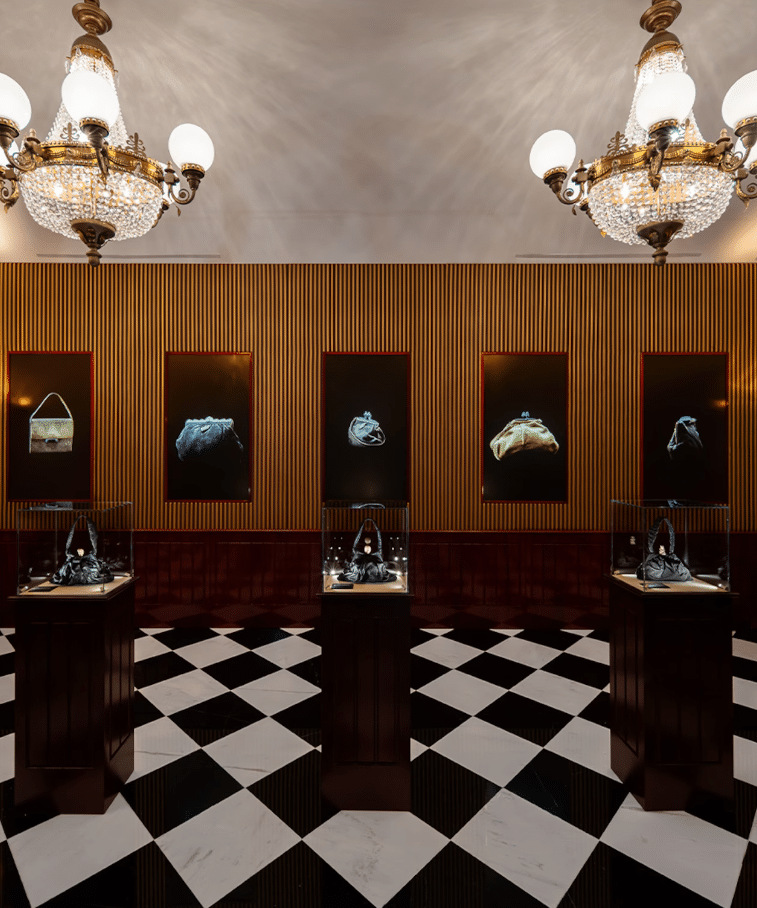
Image credit: Prada
39. Pradasphere II, Shanghai
Another brand moving from retail to a gallery aesthetic is Prada, reinforcing fashion as an art exhibition.
Prada launched its expansive and immersive Pradasphere II, designed to show the history of the brand from its beginnings in 1913, incorporating some 400 plus objects from the Prada archives.
It is an impressive display, demonstrating Prada’s connections with artists, film makers, sport and culture over decades. Exhibitions display footage of the original shop in Milan, collaborations with directors Ridley Scott and Wes Anderson, and photographs of the first collection. There are also new items, from artworks by Damien Hurst, to skirts created exclusively for Shanghai, and a sailing simulator for the Luna Rossa.
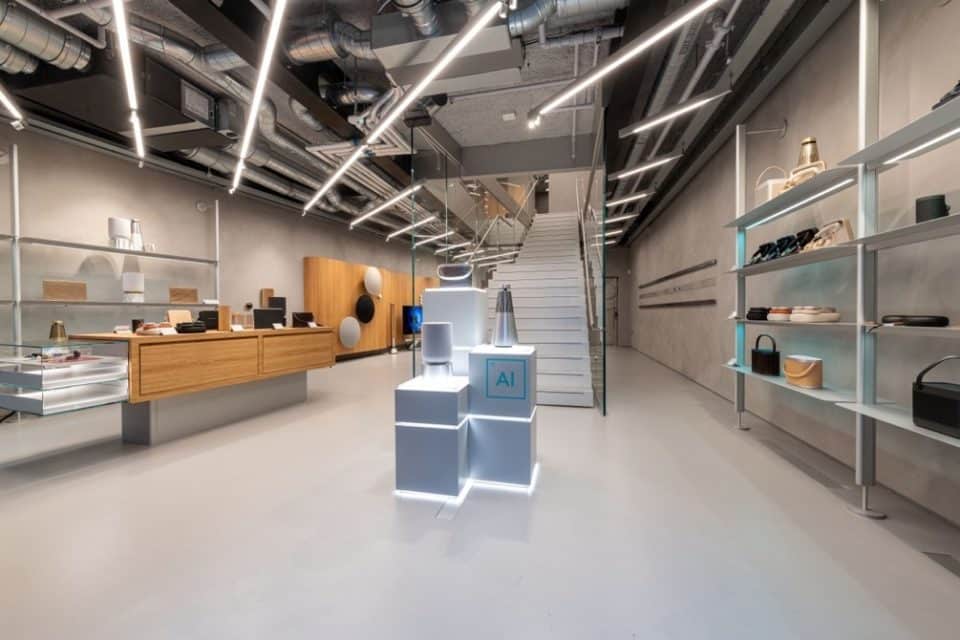
Image credit: Bang & Olufsen
40. Bang & Olufsen, London
Many high-end retailers understand that they need to make their spaces as inviting and luxurious as possible, and Bang & Olufsen have delivered in London.
The store has been designed to create a sensory experience, with an impressive visual look, Sensorium and bespoke creation area. Customers are greeted with a visual display of products that are housed against contrasting fixtures and fittings. The Sensorium, on the lowest floor, is located behind automatic doors that allow customers to privately test out Bang & Olufsen sound.
Customers who want a unique product can go to the top floor for bespoke solutions. The space has a relaxing home feel to allow customers to choose from a range of materials and designs.
Sustainable retail
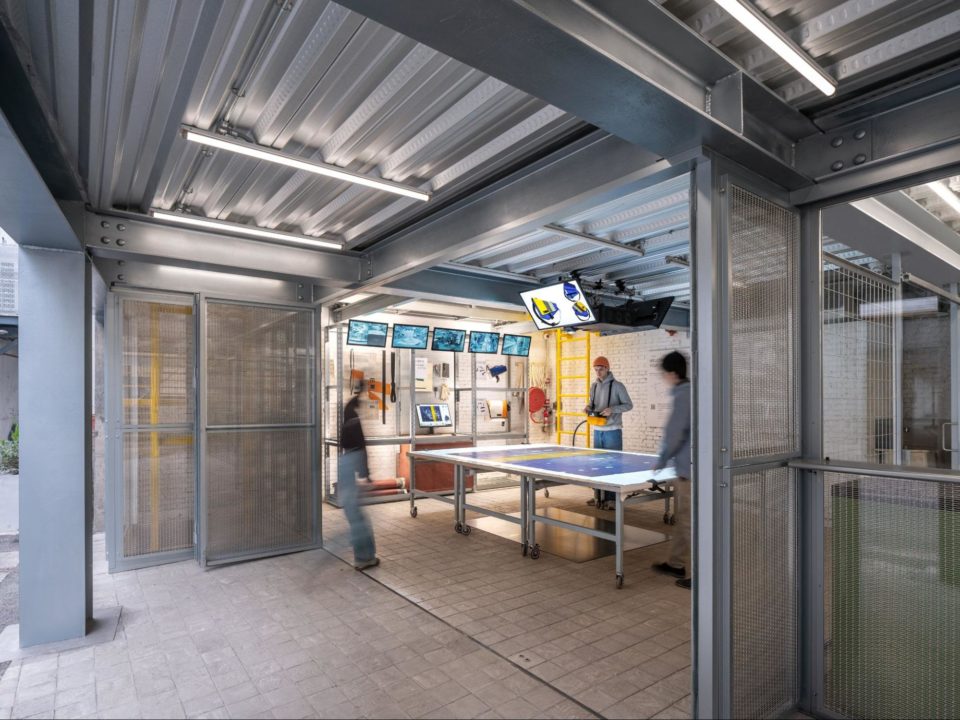
Image credit: Freitag
41. Freitag, Shanghai
While some brands are looking to vintage reselling as part of their sustainability efforts, Freitag has considered sustainability throughout its entire business.
This includes the design of the store itself, with discarded materials and building rubble used in construction to reduce emissions. Recycled truck tarps are offered as a fabric for customers to create a new bag from, or there is the option to repair and personalise existing items.
There is also a rooftop community garden, made up of organic plants and others local to the area, which is an important consideration for sustainable gardening. As well as providing customers with the opportunity to get into nature, it is also a nice reminder of what they are protecting when they choose sustainable products.
42. Pickle, NYC
Many atypical digital retailers took their first steps into physical retail this year, such as sustainable fashion rental site Pickle, which allows users to rent out their clothing to other users.
The company is using the physical space to curate a selection of items for customers to rent, but also providing more support to those renting out items on the site. A physical store gives the clothing greater prominence, and there are also content creation services available, such as photography.
To support customers, Pickle is also following another retail trend of providing access to in-house stylists for fashion expertise.
43. Zero Waste Daniel, NYC
Committing to zero waste is a laudable goal, particularly in fashion retail. Yet Zero Waste Daniel is so committed it included the words in its brand name.
The store takes discarded fabrics that other fashion brands do not use and creates beautiful and unique clothing from them. This discarded fabric is also used throughout the store, as part of the décor, to ensure that truly, nothing is wasted.
The aim in future is to use waste from other businesses in the local area, expanding from fashion and clothing, to helping the community. As part of this, Zero Waste Daniel also held workshops for visitors to learn more about how to be sustainable.
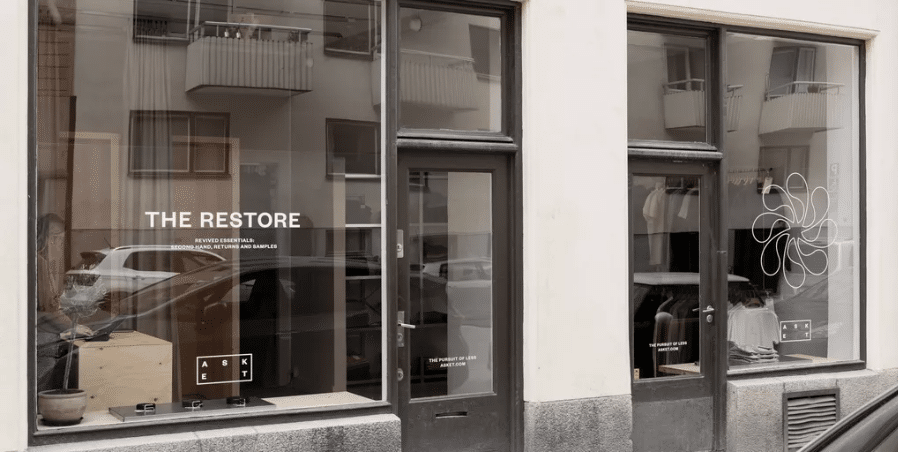
Image credit: Asket
44. Asket Restore, Stockholm
Asket launched a new store dedicated to restored and repaired clothing called Asket Restore.
The brand started a Revival Programme in 2021 to collect Asket clothing, which it then resold via pop-ups. The launch of a permanent space suggests that Asket is confident about the future of reselling clothes and sustainability in fashion is not going anywhere.
The store will also sell samples and returned items that cannot be sold in other stores. In the future, the brand hopes to offer repair tutorials to customers so that they can learn how to mend items themselves.
45. WRHS13, London
Another store aiming to not waste anything is fashion retailer WRHS13, from designer Natasha Zinko, with her unusual store aesthetic.
The store uses a lot of cardboard as part of its décor, from cardboard signs for items, to cardboard displays. Natasha has also reused other items, to give the whole space a utilitarian feel. Unused stock and customer orders are stored out in the retail space, between displays, which makes it seem like a cross between a warehouse and a market.
With the store acting as the dispatch hub for online orders as well, it’s a great example of how physical retail space can work harder for brands.
46. Timberland, NYC
How a brand communicates sustainability not only provides transparency, but is an important way for customers to understand what they are doing. Timberland has ensured that staff are well versed in its efforts in this area.
The circular economy is a well-known aspect of sustainability, which Timberland has adopted as Timberloop. This allows customers to earn 20% off for taking in their old items, which are either refurbished and resold, or recycled for parts.
There are also other services available to increase the longevity of Timberland items, such as repairs and cleaning. Embroidery and laser etching can either add a unique flair to new items, or give older items a new lease of life.
Pop-up Stores
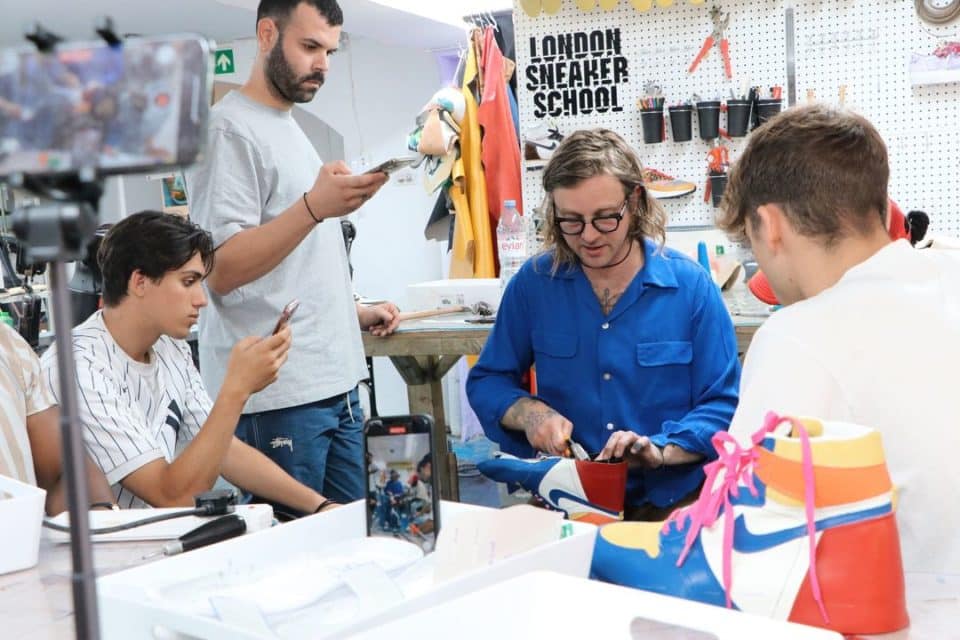
Image credit: London Sneaker School
47. London Sneaker School, London
For one-of-a-kind items, consumers can be fascinated by the design and craft process, which makes the London Sneaker School’s (LSS) pop-up education and retail space the perfect combination for curious customers.
Sneaker fans and shoppers could take part in the process, receive advice from designers, and enrol in LSS’s courses themselves. Artists from Canvvs were available to personalise items, which could then be bought in the space.
The location of the pop-up in Savile Row was also interesting, putting sneakers alongside the traditional tailored garments of the area and emphasising the craftsmanship involved.
48. Pinterest 2024 Trends, NYC
Pinterest trend predictions are hotly anticipated by marketers and retailers, as the report analyses the searches that happen on the platform to work out what consumers are interested in for the following year.
The social media platform took it one step further for 2024 by creating a pop-up store in New York City to showcase the 2024 predictions, and a curated selection of items from each of the trends. Pinterest also created an online store, the Pinterest Predicts Shop, with a further choice of trending products.
This demonstrates that social commerce is here to stay, and that the use of trend predictions by platforms like Pinterest can help curate fashionable products for visitors to not only pin but also buy.
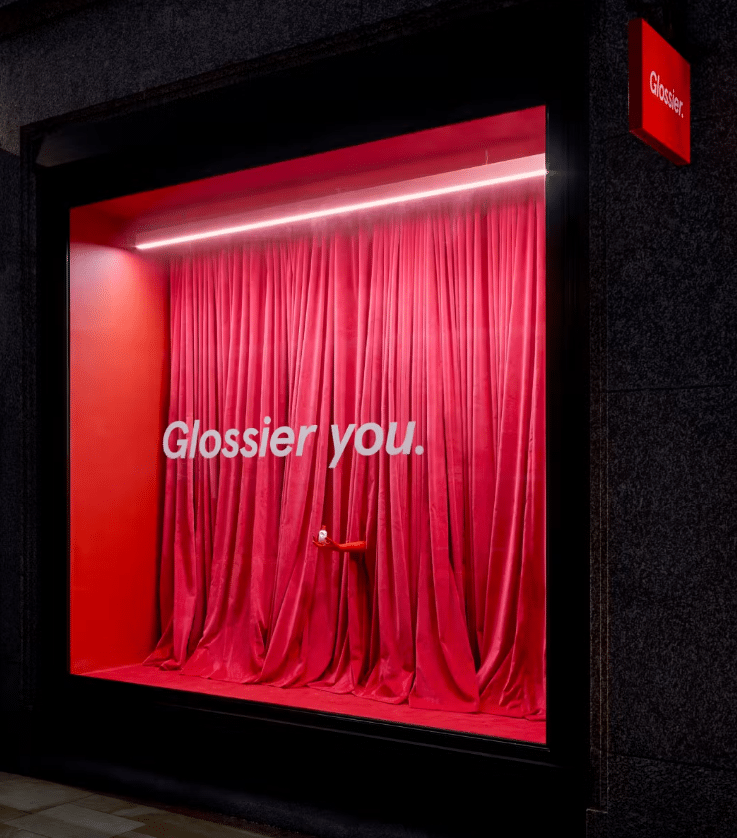
Image credit: Glossier
49. Glossier You, London
ASMR (autonomous sensory meridian response) has been a hugely popular trend on social media but we did not anticipate seeing it as part of a store!
Glossier wanted to make an experiential pop-up to excite the senses as part of the promotion for its Glossier You perfume, with a range of different sensory rooms. The ASMR room includes a video of sounds that evoke the perfume.
The brand also included theatrical elements, including a series of gloved hands with distinct personalities for people to shake. Visual elements were unusually sized items and distorted selfie mirrors, like Alice in Wonderland and fun fairs.
Only a small number of people could enter the space at a time, which elevated the experience and shows how luxurious elements are coming to all areas of retail.
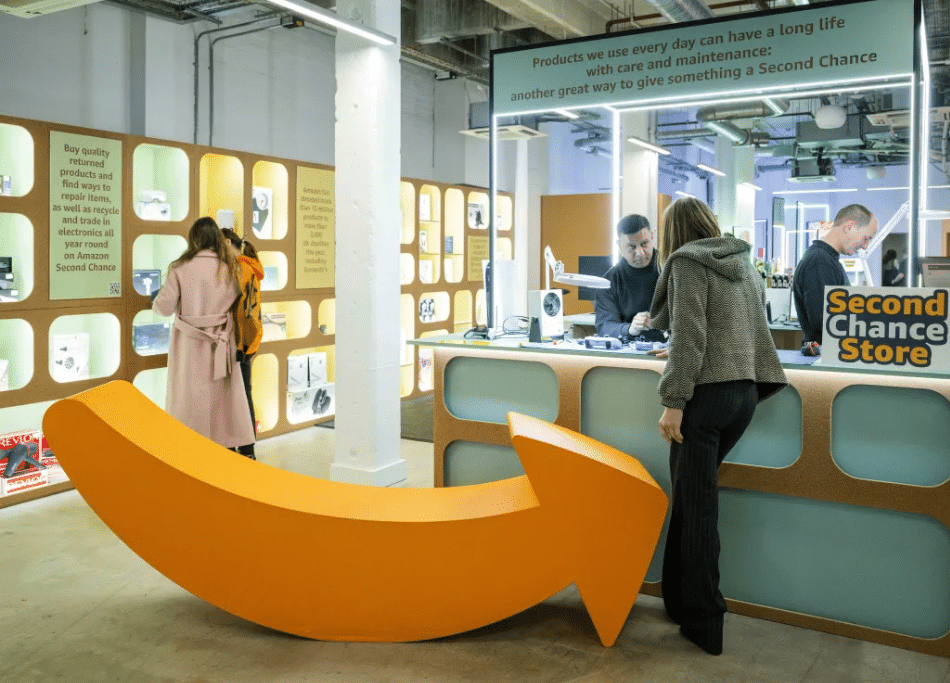
Image credit: Amazon
50. Amazon Second Chance pop-up, London
Offering repair services is fast becoming one of the most popular additions to retail stores, particularly given concerns about sustainability.
Amazon created a pop-up store at Christmas that sold returned, refurbished and unused products from its e-commerce empire. Products included popular Amazon devices Kindle and Ring, as well as toys and books, kitchen and electrical, and household goods. Proceeds went to charity Barnardo’s.
The space featured a Repairs Zone to encourage and teach customers how to repair a number of items. Technology can be some of the trickiest items to repair on one’s own, and Amazon brought in GXO Service Tech to give workshops.
It shows how physical spaces like this for the resale and repair of products could be one way that retailers tackle the returns challenge in 2024.
Start your 2024 retail year off strong – talk to us about a bespoke sector report to show you the opportunities you’re missing.

